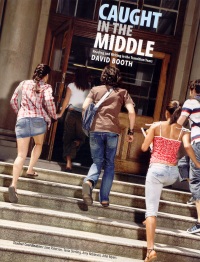| ________________
CM . . . . Volume XVIII Number 22 . . . . February 10, 2012
In Booth's updated version on the subject of Reading and Writing in the Middle Years, he has sought to pay attention to the changes that have occurred both inside and outside of schools over the last 10 years, especially in the field of literacy – reading, writing, viewing, representing, speaking and listening. One of the most significant changes in education, he expounds, comes through the impact of computer technology, creating a world which "is now one globe educationally" as students have access through the Internet to international information. Booth, along with a team of teachers and other professional educators, explores the question: How will all this change the literacy goals for schools educating students for the 21st century? Within the chapters of this collective text, contributors have shared examples of their teaching philosophies and best practices, their approaches to assessment, and their reflective conversations. In Part A, Towards A Literate Future, Booth contributes the writing, discussing literacy strategies in three chapters:
1. In the Classroom: Student Engagement, Teacher Support; He acknowledges the six literacy strands must be approached through a variety of perspectives, texts, strategies, and tools, and he offers anecdotal stories and reflective classroom practice to illustrate his intent. In one example, where a group of Grade 7's in an all-boys classroom had been provided with iPads for one year as part of a research project, Booth shares the benefits of the technology:
In Part B. Helping Students Find Their Voices, the book's last seven chapters, Booth introduces teaching stories/practices from 33 other colleagues in the education field:
4. Engaging Students in Learning Each of the chapters presents a collection of at least four or more selections shared by different educators (with the exception of Chapter 6, which has two selections). Some of the topics discussed, described, and reflected on are "Achieving Student Engagement by Seeking Social Justice" by Kevin Sebastian, "Fantasy Fiction: An Interactive Genre Study" by David Willoughby, and "Discovering Their Voices: Critical Literacy on the Web" by Lisa Hascal. The educator who seeks out this text as a literacy resource will find a diverse collection of relevant material to support their own teaching/classroom practices. As always, David Booth brings teachers yet another excellent resource for literacy in the digital world, and he does it by providing the educator with not only his own research and practice, but by complementing his work with the research of his colleagues. By providing such breadth and depth in the education field, from so many contributing voices, Caught in the Middle, is a valid, viable text for the classroom of today. An appendix of resources for Middle Years students, as well as an index is provided at the back of the book. Highly Recommended. Jocelyn A. Dimm is a sessional instructor at the University of Victoria where she teaches Drama Education, Language & Literacy and Young Adult Literature in the Faculty of Education.
To comment
on this title or this review, send mail to cm@umanitoba.ca.
Copyright © the Manitoba Library Association. Reproduction for personal
use is permitted only if this copyright notice is maintained. Any
other reproduction is prohibited without permission.
NEXT REVIEW |
TABLE OF CONTENTS FOR THIS ISSUE
- February 10, 2012.
AUTHORS |
TITLES |
MEDIA REVIEWS |
PROFILES |
BACK ISSUES |
SEARCH |
CMARCHIVE |
HOME |
